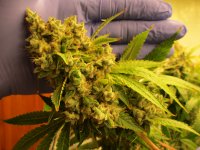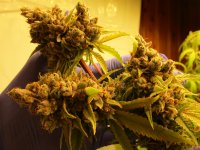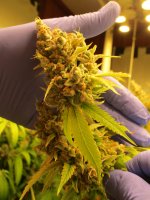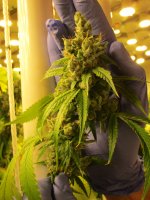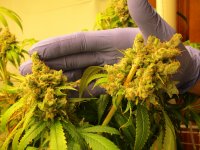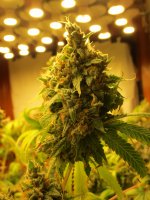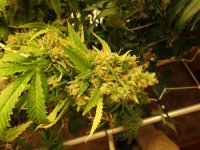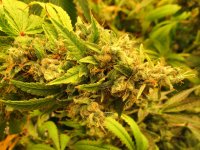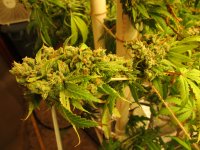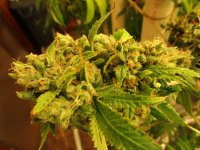Blue Star OG pheno hunt, PPK style
- Thread starter Thread starter greyfader
- Start date Start date
today marks 72 days of flowering. at 9 weeks i took another set of test flowers, dried and smoked them with my wife. we decided that #6 is the winner. it has a nice citrus fuel taste up front with a floral perfume back. very pleasant and smooth taste and smoke.
but the real story of this one is the potency. #6 and #4 both have great potency with #6 being the most potent. all the other phenos had good potency. but these 2 are about as potent as it gets.
i use a pipe with a small bowl to test with. it is about the same size as a thimble. 2 small hits and i got an invigorating, stimulating, focused high that lasted for several hours. it has a great pain-relieving effect as well.
#6 also produces well-shaped, dense flowers and produced well.
i am going to do a run with it immediately as soon as i get these plants down and change the pool configuration to one plant each. i want to see how big they can get.
some are almost done and a few will be done by the end of the week. i'm seeing a lot of opaque trichs now.
please remember, when looking at these pics, that few of them are terminal flowers. because of medical issues i had to veg them longer than i wanted and had to trim the entire canopy back like a hedge to keep them out of the lights.
these plants went into the system on april 9 and today is july 30 so this is 15 weeks these plants have been in the system. during this period absolutely no solution was removed and no changeouts occurred. this growth was accomplished using solution input only.
this is a closed-loop, recirculating system.
also, this grow was done using an 8 hour flowering period with 16 hours of darkness.
i delivered an average of 1200 umols of light for 8 hours which produced an average daily light integral of about 35 moles per day.
just a few pics of flowers at random and then the winner, #6. i will start taking them down one at a time now.
but the real story of this one is the potency. #6 and #4 both have great potency with #6 being the most potent. all the other phenos had good potency. but these 2 are about as potent as it gets.
i use a pipe with a small bowl to test with. it is about the same size as a thimble. 2 small hits and i got an invigorating, stimulating, focused high that lasted for several hours. it has a great pain-relieving effect as well.
#6 also produces well-shaped, dense flowers and produced well.
i am going to do a run with it immediately as soon as i get these plants down and change the pool configuration to one plant each. i want to see how big they can get.
some are almost done and a few will be done by the end of the week. i'm seeing a lot of opaque trichs now.
please remember, when looking at these pics, that few of them are terminal flowers. because of medical issues i had to veg them longer than i wanted and had to trim the entire canopy back like a hedge to keep them out of the lights.
these plants went into the system on april 9 and today is july 30 so this is 15 weeks these plants have been in the system. during this period absolutely no solution was removed and no changeouts occurred. this growth was accomplished using solution input only.
this is a closed-loop, recirculating system.
also, this grow was done using an 8 hour flowering period with 16 hours of darkness.
i delivered an average of 1200 umols of light for 8 hours which produced an average daily light integral of about 35 moles per day.
just a few pics of flowers at random and then the winner, #6. i will start taking them down one at a time now.
Attachments
Very nice looking light, i especially like the possibility of just adding incandesant seamlessly. Its pretty much the only light tweak i havent tried yet.hey buddy! sorry it has taken me so long to respond. i've had some medical issues to deal with.
rather than trying to answer your questions one by one i'll just ramble for a while in buckshot fashion and hope i hit all the targets.
since leaving oregon in late 2018 i have only used leds. but i have never bought a manufactured light. the reasons are that i think they are general-purpose lights designed to get you through both veg and flower and therefore compromises and not ideal. and too expensive. you know me, i'm a cheap bastard!
the general diode arrangement seems to be a combination of 3000k and 5000k phosphor-coated "white" leds. the phosphor coating method of producing "white light" starts with a blue diode and then coats it to achieve the color temperature. this makes all such diodes very strong in the blue range to start with. i think this biases the blue/red ratio too much towards blue overall for an ideal flower extension ratio. which is tied to the red/far-red elongation response. from my own experience, my led flowers are potent and terpene-heavy but don't get as large as my hps flowers did.
this ratio can be corrected by adding more dark red, far-red, and infrared. but you would only want to do this ratio offsetting during flower because in veg it would make the plants stretch too much.
conversely, a heavily blue-weighted spectrum makes for compact, sturdy plants by suppressing the elongation response. this produces tighter node spacing and more shoots.
this is why the ideal color temp for veg is 5000k/6500k.
the usual ratio of most manufactured led lights is 2/1 3000k to 5000k. then they use a few 660nm dark reds, typically less than 10% of total diode count, and maybe throw in a few 750nm range far-red just because dr bugbee mentions them online.
there are a few manufacturers making tunable lights but they are very expensive.
i've been experimenting with cheap household-type screw-in bulbs. 2700k and 5000k in various combinations and ratios. in this grow i'm using only 5000k up the end of week two of flower and then i'll switch them all out to 2700k bulbs supplemented with cheap appliance-type incandescents.
by using the 2700k only i'm reducing the overall blue/red ratio as far as possible with these phosphor-coated diodes.
my lights are being operated at 1008 watts each by using 72 14-watt bulbs.
when i switch them out with the 2700k bulbs i'll use 60 for 840 watts and then 6 25-watt incandescents for another 150 watts making it 990 watts total consumption.
incandescents have more of their output in the red/dark-red range than the sun. and far more than a hps. they have some uva. they have a controllable infrared input by using lower wattage than using leds in conjunction with hps.
i think the infrared is needed in small amounts and leds are devoid of infrared unless you put in 850nm or above diodes to produce it. infrared penetrates leaf tissue and heats the leaves internally which i think drives up the metabolic rate.
infrared radiation does not heat the medium it travels through but rather the target it hits.
on leds and metabolic rate tied to light flow, i think leds, because they are multi-point with very wide beam angles, typically 120 degrees, have a much higher light-to-shade ratio than a single-point source.
this must be driving a higher metabolic rate at the same apparent par spot readings that you get with hps.
this is coupled with the fact that approximately 30% of the electrical energy used to power a hps goes straight to heat not par light so a 1000-watt led is delivering much more energy in the par range.
this is why a 700-watt led delivers the same approx par as the 1000-watt hps.
so all this is tied to feed strength because the equivalent led is driving the metabolic rate much higher.
and tied to ambient heat as well. heat is the second most powerful regulator of metabolism after light. with leds you should run the whole room at 84-86f lights on.
i'm gonna stop for now but i'll be back!
As for tunable lights: there are a few out there but generally not so impressive. Ive done a couple DIY with led components; its a bit more efficient (the ac-dc converters in led lightbulbs are quite shitty for that), its dimmable and doesnt require changing any bulbs, you can set it up with switches or just change the way you feed the leds thru connectors/wagos. Also 100lums per watt for cold white led is very low, checking the spectrum you posted here or in the other thread it looks like they are 70cri: almost no red in their spectrum. If power consumption or cooling becomes an issue there are other ways (very easy building) to get similar or better performance with dedicated led components.
Bridgelux has a very nice strip with 2 separate channels: 5000k /2700k both in 90cri. The CRI in this case means that the spectrum has more red/far red in it (its actually about how the light renders colors but the end effect is more red). I built this little light out of these bridgelux vesta strips:


Its a bit hard to see but each line of light is actually 2 rows of leds, one cold white one warm white. The way i set it up was so that theres one circuit in the centre, one in the sides, so you can control the middle hotspot some what. Each of these circuits has its own dimable driver. Each circuit also have spectrum control, i diyed some switches that turn on cold white and warm white individually. So you can send down full power thru cold or warm white, or activate both at half power for a sorta full cycle/better efficiency mode. On the centre circuit i added some extra mono strips to add some deepreds. You could of course set it up so you could have individual drivers for each color but that means youd have to have much bigger drivers.
@greyfaderVery nice looking light, i especially like the possibility of just adding incandesant seamlessly. Its pretty much the only light tweak i havent tried yet.
As for tunable lights: there are a few out there but generally not so impressive. Ive done a couple DIY with led components; its a bit more efficient (the ac-dc converters in led lightbulbs are quite shitty for that), its dimmable and doesnt require changing any bulbs, you can set it up with switches or just change the way you feed the leds thru connectors/wagos. Also 100lums per watt for cold white led is very low, checking the spectrum you posted here or in the other thread it looks like they are 70cri: almost no red in their spectrum. If power consumption or cooling becomes an issue there are other ways (very easy building) to get similar or better performance with dedicated led components.
Bridgelux has a very nice strip with 2 separate channels: 5000k /2700k both in 90cri. The CRI in this case means that the spectrum has more red/far red in it (its actually about how the light renders colors but the end effect is more red). I built this little light out of these bridgelux vesta strips: View attachment 18891076 View attachment 18891077
Its a bit hard to see but each line of light is actually 2 rows of leds, one cold white one warm white. The way i set it up was so that theres one circuit in the centre, one in the sides, so you can control the middle hotspot some what. Each of these circuits has its own dimable driver. Each circuit also have spectrum control, i diyed some switches that turn on cold white and warm white individually. So you can send down full power thru cold or warm white, or activate both at half power for a sorta full cycle/better efficiency mode. On the centre circuit i added some extra mono strips to add some deepreds. You could of course set it up so you could have individual drivers for each color but that means youd have to have much bigger drivers.
These are the blux Vestas i talked to you about over at the other thread
Veg/full cycle/flower spectrum, individually switchable both in the centre and the sides. And separate diming for centre and perifery so you can dial in perfectly even coverage.
About 250 euros at the time but pre inflation. Efficiency 2.4-2.6 ppf/w depending on if youre using one or both channels at the same time. 300w, 3x3 coverage. But youd have to beef it up a bit if you wanna get to 1200 ppfd...
This thread is absolutely Jam packed with gold!
I've recently made the switch to LEDs from HPS and CMH ( Ive chosen to run a CMH with my LEDs in winter)
After reading this I am going to experiment with the incandescent trick on my next run.
Although I believe I have built my lights from what I believe to be the very best manufacturer LED strips available ( Grow Light Australia)
If I could do it again I would follow your example of individual house hold bulbs .
What would be your recommendation for supplemental deep red/IR light per square foot?
Cheers
I've recently made the switch to LEDs from HPS and CMH ( Ive chosen to run a CMH with my LEDs in winter)
After reading this I am going to experiment with the incandescent trick on my next run.
Although I believe I have built my lights from what I believe to be the very best manufacturer LED strips available ( Grow Light Australia)
If I could do it again I would follow your example of individual house hold bulbs .
What would be your recommendation for supplemental deep red/IR light per square foot?
Cheers
Aristoned
Well-known member
@greyfader
Have you tried a wetting agent to break the surface tension of the water to eliminate the perched water table?
Have you tried a wetting agent to break the surface tension of the water to eliminate the perched water table?
howdy! here is a link to a grow i did with the bluestar og pheno hunt winner from this grow.This thread is absolutely Jam packed with gold!
I've recently made the switch to LEDs from HPS and CMH ( Ive chosen to run a CMH with my LEDs in winter)
After reading this I am going to experiment with the incandescent trick on my next run.
Although I believe I have built my lights from what I believe to be the very best manufacturer LED strips available ( Grow Light Australia)
If I could do it again I would follow your example of individual house hold bulbs .
What would be your recommendation for supplemental deep red/IR light per square foot?
Cheers
Blue Star OG pheno hunt winner in a PPK system
i recently conducted a pheno hunt of BlueStarSeedco's cross of Blue Star x Triangle Kush. This consisted of 50 seeds of which 48 popped within 2 days. 36 were selected and of these 12 were flowered. they all had good potency but this one has great potency and the strongest flavor profile...
www.icmag.com
i have no way of measuring actual delivery of photons outside of par range but i used 924 watts of 2700k and 150 watts of incandescent or a little over 16% incandescent.
Aristoned
Well-known member
howdy! here is a link to a grow i did with the bluestar og pheno hunt winner from this grow.
Blue Star OG pheno hunt winner in a PPK system
i recently conducted a pheno hunt of BlueStarSeedco's cross of Blue Star x Triangle Kush. This consisted of 50 seeds of which 48 popped within 2 days. 36 were selected and of these 12 were flowered. they all had good potency but this one has great potency and the strongest flavor profile...www.icmag.com
i have no way of measuring actual delivery of photons outside of par range but i used 924 watts of 2700k and 150 watts of incandescent or a little over 16% incandescent.
I cannot thank you enough for the advice on the incandescent lamps, I’m using 150W currently and I have (x2) 100W bulbs and 150W bulbs coming.
Have you tried the 40W nano bulbs?
no, i have not. because i don't think it would work.@greyfader
Have you tried a wetting agent to break the surface tension of the water to eliminate the perched water table?
the perched water table occurs in every container. it's size is dependent on media particle size. the finer the medium, the greater the PWT.
it is held up against the force of gravity by cohesion (water's attraction to itself), and adhesion (water's attraction to other substances.)
the only way to eliminate the PWT in a conventional container is by transpiration through the plant or evaporation from the container.
the ppk device positively eliminates the PWT mechanically immediately after each watering event.
this allows you to water much more frequently on a timed schedule. the act of watering itself stimulates plant growth by exchanging gases, refreshing nutrients, and correcting ph on each pass.
Aristoned
Well-known member
no, i have not. because i don't think it would work.
the perched water table occurs in every container. it's size is dependent on media particle size. the finer the medium, the greater the PWT.
it is held up against the force of gravity by cohesion (water's attraction to itself), and adhesion (water's attraction to other substances.)
the only way to eliminate the PWT in a conventional container is by transpiration through the plant or evaporation from the container.
the ppk device positively eliminates the PWT mechanically immediately after each watering event.
this allows you to water much more frequently on a timed schedule. the act of watering itself stimulates plant growth by exchanging gases, refreshing nutrients, and correcting ph on each pass.
I’m going to run an experiment to see if a wetting agent will have a positive effect.
What is your medium?
you are most welcome! i've only tried 25 watt appliance bulbs thus far. they are a15 envelope bulbs so much smaller than the typical a19 household bulbs. also, you can still find them whereas the a19's are getting scarce.I cannot thank you enough for the advice on the incandescent lamps, I’m using 150W currently and I have (x2) 100W bulbs and 150W bulbs coming.
Have you tried the 40W nano bulbs?
i like the idea of more low wattage bulbs functioning in the same working plane as the led bulbs rather than 1 or 2 bigger, higher wattage bulbs projecting significantly below the leds. i think this spreads the radiation out more evenly and reduces hot spots.
these are what i'm using.
25W, Clear, Incandescent A15 Bulb, Medium Base, 130V, Satco S3814 | 1000Bulbs.com
Shop for Satco S3814 25 watt A15 light bulb. Lasts 2,500 hours and produces 130 lumens at 130V. The best prices on 25 watt light bulbs at 1000bulbs.com!
Last edited:
i'm using #2 perlite amended with worm castings and diatomaceous earth. to the continuous liquid feed i add 1ml per gallon of mr fulvic and a heaping tsp of maxigro kelp powder. 85% phosphoric acid as ph down.I’m going to run an experiment to see if a wetting agent will have a positive effect.
What is your medium?
no solution was removed during the grow except at the end where i drained and refilled with ph corrected water. 12 weeks of input only.
Aristoned
Well-known member
you are most welcome! i've only tried 25 watt appliance bulbs thus far. they are a15 envelope bulbs so much smaller than the typical a19 household bulbs. also, you can still find them whereas the a19's are getting scarce.
i like the idea of more low wattage bulbs functioning in the same working plane as the led bulbs rather than 1 or 2 bigger, higher wattage bulbs projecting significantly below the leds. i think this spread the radiation out more evenly and reduces hot spots.
these are what i'm using.
25W, Clear, Incandescent A15 Bulb, Medium Base, 130V, Satco S3814 | 1000Bulbs.com
Shop for Satco S3814 25 watt A15 light bulb. Lasts 2,500 hours and produces 130 lumens at 130V. The best prices on 25 watt light bulbs at 1000bulbs.com!www.1000bulbs.com
The picture below is the 40W nano infrared bulbs I’m looking for. The 75W comes in the R40 shape, if I’m not mistaken, which makes it difficult to manage with strips. The COB’s have room all around so I have flexibility.
I’m imagining the 100W and the 150W to produce more visible light than the 75W, in an almost linear fashion, with the coating I should still get plenty more IR over the visible spectrum as compared to the “daylight” style.
If I were to use incandescent as a main source and not a supplemental source then I could see the A-series as an option. Do they still allow incandescent bulbs for use with lizards and snakes in Europe?
I would think the best way to stop the ban on incandescent is to promote the experiments that prove the IR light from incandescent lamps has a positive effect on our Health & Well-being while the LED is having an adverse effect.
Basically, what is good for the plants is good for us.
The picture below is the 40W nano infrared bulbs I’m looking for. The 75W comes in the R40 shape, if I’m not mistaken, which makes it difficult to manage with strips. The COB’s have room all around so I have flexibility.
View attachment 19176977
I’m imagining the 100W and the 150W to produce more visible light than the 75W, in an almost linear fashion, with the coating I should still get plenty more IR over the visible spectrum as compared to the “daylight” style.
View attachment 19176983
If I were to use incandescent as a main source and not a supplemental source then I could see the A-series as an option. Do they still allow incandescent bulbs for use with lizards and snakes in Europe?
View attachment 19176984
I would think the best way to stop the ban on incandescent is to promote the experiments that prove the IR light from incandescent lamps has a positive effect on our Health & Well-being while the LED is having an adverse effect.
View attachment 19176985
Basically, what is good for the plants is good for us.
thank you! i didn't know those nano bulbs existed. is the second graph the spectral distribution of it or generic?The picture below is the 40W nano infrared bulbs I’m looking for. The 75W comes in the R40 shape, if I’m not mistaken, which makes it difficult to manage with strips. The COB’s have room all around so I have flexibility.
View attachment 19176977
I’m imagining the 100W and the 150W to produce more visible light than the 75W, in an almost linear fashion, with the coating I should still get plenty more IR over the visible spectrum as compared to the “daylight” style.
View attachment 19176983
If I were to use incandescent as a main source and not a supplemental source then I could see the A-series as an option. Do they still allow incandescent bulbs for use with lizards and snakes in Europe?
View attachment 19176984
I would think the best way to stop the ban on incandescent is to promote the experiments that prove the IR light from incandescent lamps has a positive effect on our Health & Well-being while the LED is having an adverse effect.
View attachment 19176985
Basically, what is good for the plants is good for us.
i don't know about availability in europe as i don't live there. but the bans on incandescent seem to be focused on a19 and a21 envelopes as they are the most common household types and would represent the greatest frequency of use.
the appliance bulbs i use will be around a long time as will heat bulbs for hatching bird eggs.
the appliance bulbs are rated for extremes of heat and cold and are vibration-resistant.
Aristoned
Well-known member
thank you! i didn't know those nano bulbs existed. is the second graph the spectral distribution of it or generic?
i don't know about availability in europe as i don't live there. but the bans on incandescent seem to be focused on a19 and a21 envelopes as they are the most common household types and would represent the greatest frequency of use.
the appliance bulbs i use will be around a long time as will heat bulbs for hatching bird eggs.
the appliance bulbs are rated for extremes of heat and cold and are vibration-resistant.
When I saw the 2.5” bulbs I lost it!
I can spread 200W of IR across the top of the canopy without even trying.
It was my assumption you lived in Europe, I can find incandescent bulbs everywhere they just don’t have as many as the LED replacements. I would also assume that horticulture and agriculture would maintain the incandescent and halogen lamps as there is no replacement for them. Another assumption is that the bulbs used for live-stock and agriculture are going to have higher quality and better spectrum accuracy.
The second graph is a generic graph for incandescent bulbs, halogen has slightly more visible light than incandescent and is more powerful. I prefer incandescent for my use-case.
yeah, i really don't see the point of using halogen as the incandescent covers all nm in a kinder, gentler fashion.When I saw the 2.5” bulbs I lost it!
I can spread 200W of IR across the top of the canopy without even trying.
It was my assumption you lived in Europe, I can find incandescent bulbs everywhere they just don’t have as many as the LED replacements. I would also assume that horticulture and agriculture would maintain the incandescent and halogen lamps as there is no replacement for them. Another assumption is that the bulbs used for live-stock and agriculture are going to have higher quality and better spectrum accuracy.
The second graph is a generic graph for incandescent bulbs, halogen has slightly more visible light than incandescent and is more powerful. I prefer incandescent for my use-case.
some reptile enthusiasts say that halogen can cause "dessication", which i interpret as drying.
Aristoned
Well-known member
yeah, i really don't see the point of using halogen as the incandescent covers all nm in a kinder, gentler fashion.
some reptile enthusiasts say that halogen can cause "dessication", which i interpret as drying.
Desiccation is drying for sure, the 250W halogen would have covered two plants with ease, but like you, I prefer to soften the IR and spread it more.
Too many ideas right now, I need to build something!

